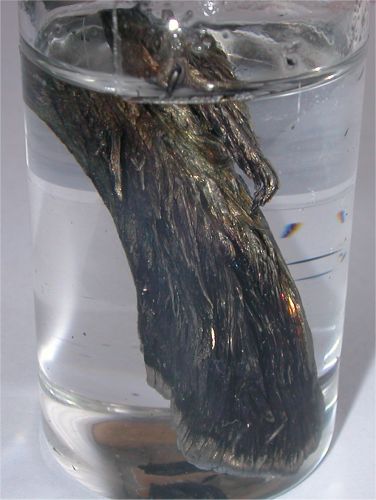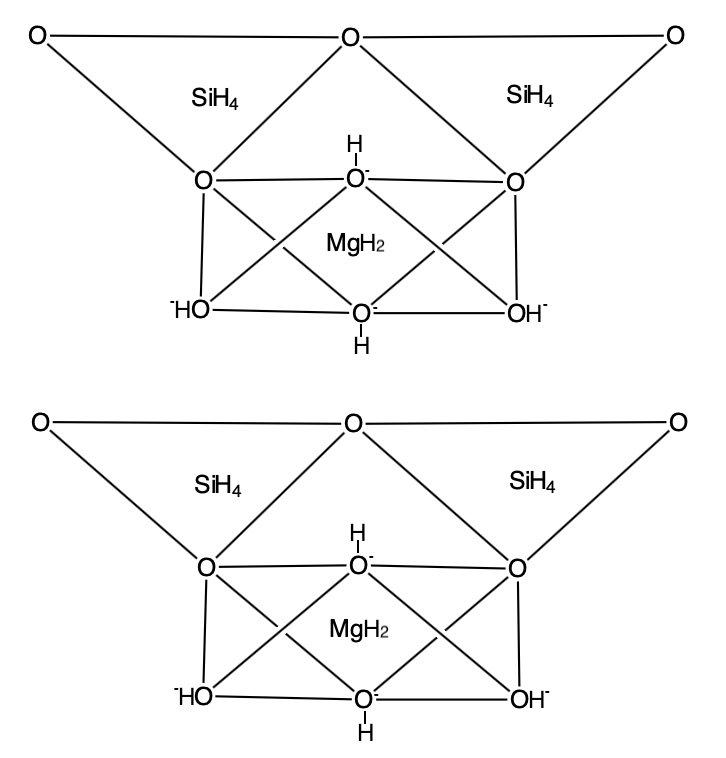|
Berborite
Berborite is a beryllium borate mineral with the chemical formula Be2(BO3)(OH,F)·(H2O). It is colorless and leaves a white streak. Its crystals are hexagonal to pyramidal. It is transparent and has vitreous luster. It is not radioactive. Berborite is rated 3 on the Mohs Scale. Berborite occurs in 1T, 2T, 2H polytypes. It was first described in 1967 for an occurrence in the Lupikko Mine, Ladoga Region Karelia Republic, Russia. It has also been reported from Tvedalen, Larvik, Vestfold, and Siktesøya Island, Langesundsfjord, Porsgrunn, Telemark, Norway. It occurs in serpentine altered dolomite in association with skarn enriched in tungsten, strontium, beryllium and boron in the Karelia occurrence and in vugs with natrolite Natrolite is a tectosilicate mineral species belonging to the zeolite group. It is a hydrated sodium and aluminium silicate with the formula . The type locality is Hohentwiel, Hegau, Germany. It was named natrolite by Martin Heinrich Klaprot ... and ... [...More Info...] [...Related Items...] OR: [Wikipedia] [Google] [Baidu] |
Borate Minerals
The Borate Minerals are minerals which contain a borate anion group. The borate (BO3) units may be polymerised similar to the SiO4 unit of the silicate mineral class. This results in B2O5, B3O6, B2O4 anions as well as more complex structures which include hydroxide or halogen anions.Klein, Cornelis and Cornelius Hurlbut, Jr., ''Manual of Mineralogy'', Wiley, 20th ed., 1985 pp. 343 - 347 The (O,OH)4sup>− anion exists as well. Many borate minerals, such as borax, colemanite, and ulexite, are salts: soft, readily soluble, and found in evaporite contexts. However, some, such as boracite, are hard and resistant to weathering, more similar to the silicates. There are over 100 different borate minerals. Vanadates), 09 Silicates: * ''neso-'': insular (from Greek , "island") * ''soro-'': grouped (from Greek , "heap, pile, mound") * ''cyclo-'': rings of (from Greek , "circle") * ''ino-'': chained (from Greek , "fibre", rom Ancient Greek * ''phyllo-'': sheets of (from Greek , ... [...More Info...] [...Related Items...] OR: [Wikipedia] [Google] [Baidu] |
Boron
Boron is a chemical element; it has symbol B and atomic number 5. In its crystalline form it is a brittle, dark, lustrous metalloid; in its amorphous form it is a brown powder. As the lightest element of the boron group it has three valence electrons for forming covalent bonds, resulting in many compounds such as boric acid, the mineral sodium borate, and the ultra-hard crystals of boron carbide and boron nitride. Boron is synthesized entirely by cosmic ray spallation and supernovas and not by stellar nucleosynthesis, so it is a low-abundance element in the Solar System and in the Earth's crust. It constitutes about 0.001 percent by weight of Earth's crust. It is concentrated on Earth by the water-solubility of its more common naturally occurring compounds, the borate minerals. These are mined industrially as evaporites, such as borax and kernite. The largest known deposits are in Turkey, the largest producer of boron minerals. Elemental boron is found in smal ... [...More Info...] [...Related Items...] OR: [Wikipedia] [Google] [Baidu] |
Strontium
Strontium is a chemical element; it has symbol Sr and atomic number 38. An alkaline earth metal, it is a soft silver-white yellowish metallic element that is highly chemically reactive. The metal forms a dark oxide layer when it is exposed to air. Strontium has physical and chemical properties similar to those of its two vertical neighbors in the periodic table, calcium and barium. It occurs naturally mainly in the minerals celestine and strontianite, and is mostly mined from these. Both strontium and strontianite are named after Strontian, a village in Scotland near which the mineral was discovered in 1790 by Adair Crawford and William Cruickshank; it was identified as a new element the next year from its crimson-red flame test color. Strontium was first isolated as a metal in 1808 by Humphry Davy using the then newly discovered process of electrolysis. During the 19th century, strontium was mostly used in the production of sugar from sugar beets (see strontian proces ... [...More Info...] [...Related Items...] OR: [Wikipedia] [Google] [Baidu] |
Tungsten
Tungsten (also called wolfram) is a chemical element; it has symbol W and atomic number 74. It is a metal found naturally on Earth almost exclusively in compounds with other elements. It was identified as a distinct element in 1781 and first isolated as a metal in 1783. Its important ores include scheelite and wolframite, the latter lending the element its alternative name. The free element is remarkable for its robustness, especially the fact that it has the highest melting point of all known elements, melting at . It also has the highest boiling point, at . Its density is 19.254 g/cm3, comparable with that of uranium and gold, and much higher (about 1.7 times) than that of lead. Polycrystalline tungsten is an intrinsically brittle and hard material (under standard conditions, when uncombined), making it difficult to work into metal. However, pure single-crystalline tungsten is more ductile and can be cut with a hard-steel hacksaw. Tungsten occurs in many alloys ... [...More Info...] [...Related Items...] OR: [Wikipedia] [Google] [Baidu] |
Skarn
Skarns or tactites are coarse-grained metamorphic rocks that form by replacement of carbonate-bearing rocks during regional or contact metamorphism and metasomatism. Skarns may form by metamorphic recrystallization of impure carbonate protoliths, bimetasomatic reaction of different lithologies, and infiltration metasomatism by magmatic- hydrothermal fluids. Skarns tend to be rich in calcium-magnesium-iron-manganese-aluminium silicate minerals, which are also referred to as calc-silicate minerals.Ray, G.E., and Webster, I.C.L. (1991): An Overview of Skarn Deposits; in Ore Deposits, Tectonics and Metallogeny in the Canadian Cordillera; McMillan, W.J., compiler, B. C. Ministry of Energy, Mines and Petroleum Resources, Paper 1991-4, pages 213-252.Meinert, L.D., 1992. Skarns and Skarn Deposits; Geoscience Canada, Vol. 19, No. 4, p. 145-162.Hammarstrom, J.M., Kotlyar, B.B., Theodore, T.G., Elliott, J.E., John, D.A., Doebrich, J.L., Nash, J.T., Carlson, R.R., Lee, G.K., Livo, K.E., Klein ... [...More Info...] [...Related Items...] OR: [Wikipedia] [Google] [Baidu] |
Dolomite (rock)
Dolomite (also known as dolomite rock, dolostone or dolomitic rock) is a sedimentary rock, sedimentary carbonate rock that contains a high percentage of the mineral Dolomite (mineral), dolomite, CaMg(CO3)2. It occurs widely, often in association with limestone and evaporites, though it is less abundant than limestone and rare in Cenozoic rock beds (beds less than about 66 million years in age). One of the first geologists to distinguish dolomite from limestone was Déodat Gratet de Dolomieu, a French mineralogist and geologist after whom it is named. He recognized and described the distinct characteristics of dolomite in the late 18th century, differentiating it from limestone. Most dolomite was formed as a magnesium replacement of limestone or of Lime (mineral), lime mud before lithification. The geological process of conversion of calcite to dolomite is known as dolomitization and any intermediate product is known as dolomitic limestone. The "dolomite problem" refers to the v ... [...More Info...] [...Related Items...] OR: [Wikipedia] [Google] [Baidu] |
Serpentine Group
Serpentine subgroup (part of the kaolinite-serpentine group in the category of phyllosilicates) are greenish, brownish, or spotted minerals commonly found in serpentinite. They are used as a source of magnesium and asbestos, and as decorative stone. The name comes from the greenish color and smooth or scaly appearance from the Latin , meaning "snake-like". Serpentine subgroup is a set of common rock-forming hydrous magnesium iron phyllosilicate () minerals, resulting from the metamorphism of the minerals that are contained in mafic to ultramafic rocks. They may contain minor amounts of other elements including chromium, manganese, cobalt or nickel. In mineralogy and gemology, serpentine may refer to any of the 20 varieties belonging to the serpentine subgroup. Owing to admixture, these varieties are not always easy to individualize, and distinctions are not usually made. There are three important mineral polymorphs of serpentine: antigorite, lizardite and chrysotile. ... [...More Info...] [...Related Items...] OR: [Wikipedia] [Google] [Baidu] |
Norway
Norway, officially the Kingdom of Norway, is a Nordic countries, Nordic country located on the Scandinavian Peninsula in Northern Europe. The remote Arctic island of Jan Mayen and the archipelago of Svalbard also form part of the Kingdom of Norway. Bouvet Island, located in the Subantarctic, is a Dependencies of Norway, dependency, and not a part of the Kingdom; Norway also Territorial claims in Antarctica, claims the Antarctic territories of Peter I Island and Queen Maud Land. Norway has a population of 5.6 million. Its capital and largest city is Oslo. The country has a total area of . The country shares a long eastern border with Sweden, and is bordered by Finland and Russia to the northeast. Norway has an extensive coastline facing the Skagerrak strait, the North Atlantic Ocean, and the Barents Sea. The unified kingdom of Norway was established in 872 as a merger of Petty kingdoms of Norway, petty kingdoms and has existed continuously for years. From 1537 to 1814, Norway ... [...More Info...] [...Related Items...] OR: [Wikipedia] [Google] [Baidu] |
Telemark
Telemark () is a Counties of Norway, county and a current electoral district in Norway. Telemark borders the counties of Vestfold, Buskerud, Vestland, Rogaland and Agder. In 2020, Telemark merged with the county of Vestfold to form the county of Vestfold og Telemark. On 1 January 2024, the county of Telemark was re-established after Vestfold og Telemark was divided again. The name ''Telemark'' means the "March (territorial entity), mark of the Thelir", the ancient North Germanic peoples, North Germanic tribe that inhabited what is now known as Upper Telemark in the Migration Period and the Viking Age. In the Middle Ages, the agricultural society of Upper Telemark was considered the most violent region of Norway. Today, half of the buildings from medieval times in Norway are located here. The dialects spoken in Upper Telemark also retain more elements of Old Norse than those spoken elsewhere in the country. Upper Telemark is also known as the birthplace of skiing. The southern ... [...More Info...] [...Related Items...] OR: [Wikipedia] [Google] [Baidu] |
Porsgrunn
is a List of municipalities of Norway, municipality in Telemark county, Norway. It is located in the Traditional districts of Norway, traditional district of Grenland. The administrative centre of the municipality is the Porsgrunn (town), city of Porsgrunn. Some other notable settlements in Porsgrunn include the town of Brevik, Norway, Brevik and the villages of Langangen and Heistad. The municipality is the 315th largest by area out of the 356 municipalities in Norway. Porsgrunn is the 29th most populous municipality in Norway with a population of 37,056. The municipality's population density is and its population has increased by 4.7% over the previous 10-year period. The conurbation of the cities of Porsgrunn (town), Porsgrunn and Skien (town), Skien is called Porsgrunn/Skien by Statistics Norway and it is considered to be the List of urban areas in Norway by population, seventh-largest urban area in Norway. General information The Porsgrunn (town), town of Porsgrunn was ... [...More Info...] [...Related Items...] OR: [Wikipedia] [Google] [Baidu] |
Langesundsfjord
Langesundsfjord (), also known as the Breviksfjord (), is a stretch of fjord in Telemark county, Norway. The long fjord flows from the Skagerrak, between the islands of Sandøya, Bjørkøya, and Siktesøya in Porsgrunn Municipality and the mainland of Bamble Municipality. Location The fjord stretches from the Langesund strait near the town of Brevik, where it separates into the Frierfjord and the Eidangerfjord. In the medieval period, the fjord was named ''Grenmar'', after the ''grener'' people who lived here and ''mar'' which was Old Norse for sea. Later, well into the 1700s, the entire stretch from Langesund gap and up to Skien was referred to as Langesundsfjord. The Brevik Bridge is a bridge over the mouth of the Frierfjord that connects the municipalities of Bamble and Porsgrunn. On the west side of Bamble lies the town of Stathelle. On the east side lies the town of Brevik in Porsgrunn. The Brevik tunnel (''Brevikstunnelen'') on Highway 354 (old E18) goes through the ... [...More Info...] [...Related Items...] OR: [Wikipedia] [Google] [Baidu] |








